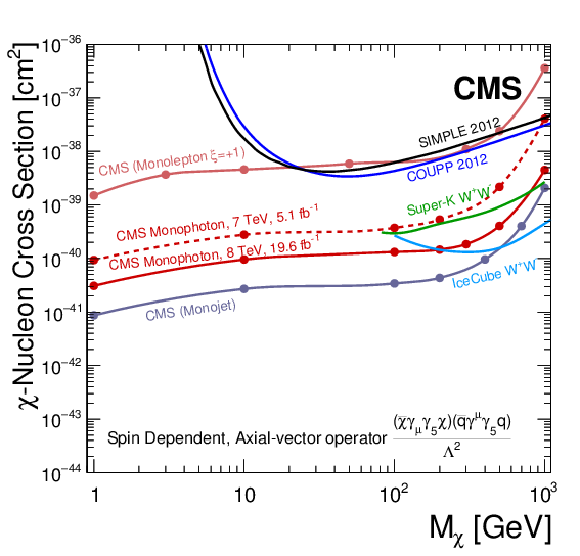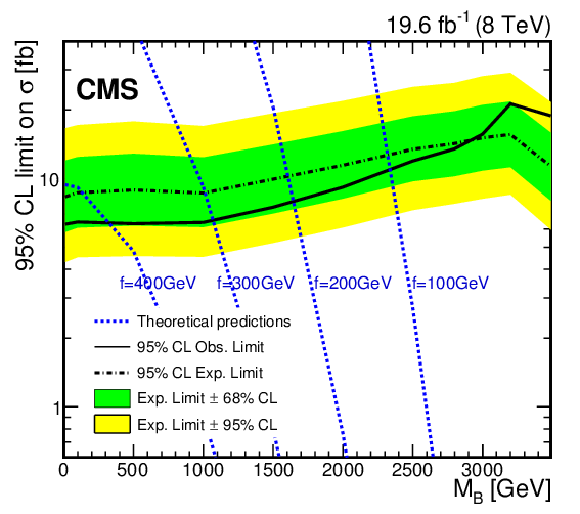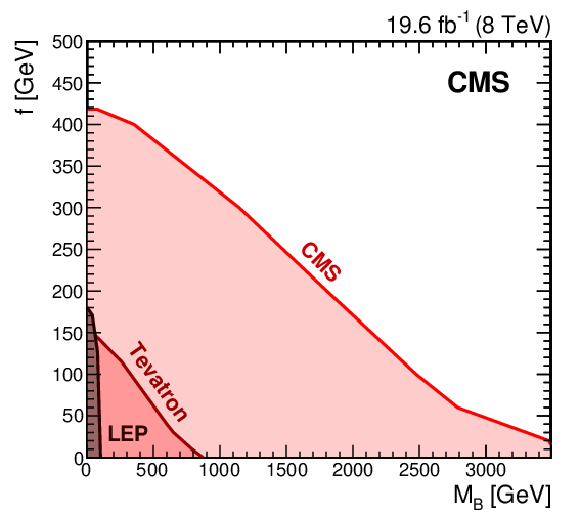

Compact Muon Solenoid
LHC, CERN
| CMS-EXO-12-047 ; CERN-PH-EP-2014-253 | ||
| Search for new phenomena in monophoton final states in proton-proton collisions at $\sqrt{s}$ = 8 TeV | ||
| CMS Collaboration | ||
| 31 October 2014 | ||
| Phys. Lett. B 755 (2016) 102 | ||
| Abstract: Results are presented from a search for new physics in final states containing a photon and missing transverse momentum. The data correspond to an integrated luminosity of 19.6 fb$^{-1}$ collected in proton-proton collisions at $\sqrt{s}=8~\mathrm{TeV}$ with the CMS experiment at the CERN LHC. No deviation from the standard model predictions is observed for these final states. New, improved limits are set on dark matter production and on parameters of models with large extra dimensions. In particular, the first limits on branon production at a hadron collider are found and significantly extend previous limits from LEP. A cross section upper limit of 14.0 fb is set at the 95% confidence level for events with a monophoton final state with photon transverse momentum greater than 145 GeV and missing transverse momentum greater than 140 GeV. | ||
| Links: e-print arXiv:1410.8812 [hep-ex] (PDF) ; CDS record ; inSPIRE record ; Public twiki page ; CADI line (restricted) ; | ||
| Figures | |

png pdf |
Figure 1-a:
The photon $ {E_{\mathrm {T}}} $ and $ {E_{\mathrm {T}}} $ distributions for the candidate sample, compared with estimated contributions from SM backgrounds, and the predictions from the ADD model for $ {{M_\mathrm {D}}} =$ 2 TeV and $n=$ 3. The horizontal bar on each data point indicates the width of the bin. The background uncertainty includes statistical and systematic components. The bottom panel shows the ratio of data and SM background predictions. |

png pdf |
Figure 1-b:
The photon $ {E_{\mathrm {T}}} $ and $ {E_{\mathrm {T}}} $ distributions for the candidate sample, compared with estimated contributions from SM backgrounds, and the predictions from the ADD model for $ {{M_\mathrm {D}}} =$ 2 TeV and $n=$ 3. The horizontal bar on each data point indicates the width of the bin. The background uncertainty includes statistical and systematic components. The bottom panel shows the ratio of data and SM background predictions. |

png pdf |
Figure 2:
Upper limits at 95% confidence level (CL) on the product of cross section and acceptance as a function of the $ {E_{\mathrm {T}}} ^{\gamma }$ threshold ($>$145 GeV) for the photon and $ {E_{\mathrm {T}}} $ final state. |

png pdf |
Figure 3-a:
The 90% CL upper limits on the $\chi $-nucleon cross section as a function of the DM particle mass $M_{\chi }$ for spin-independent couplings (a) and spin-dependent couplings (b). Results from the current search are shown as ``CMS Monophoton, 8 TeV". Shown are the limits from CMS using monojet and monolepton signatures (where $\xi $ is the interference parameter addressing potentially different couplings to up and down-type quarks and values of $\xi = \pm 1$ maximize the effects of interference). Also shown are the limits from several published direct detection experiments. The solid and hatched yellow contours show the 68% and 95% CL contours respectively for a possible signal from CDMS. |

png pdf |
Figure 3-b:
The 90% CL upper limits on the $\chi $-nucleon cross section as a function of the DM particle mass $M_{\chi }$ for spin-independent couplings (a) and spin-dependent couplings (b). Results from the current search are shown as ``CMS Monophoton, 8 TeV". Shown are the limits from CMS using monojet and monolepton signatures (where $\xi $ is the interference parameter addressing potentially different couplings to up and down-type quarks and values of $\xi = \pm 1$ maximize the effects of interference). Also shown are the limits from several published direct detection experiments. The solid and hatched yellow contours show the 68% and 95% CL contours respectively for a possible signal from CDMS. |

png pdf |
Figure 4:
Observed limits on the SM-DM interaction mediator mass divided by coupling, $M/\sqrt {g_{\chi } g_{q}}$, as a function of the mediator mass $M$, assuming vector interactions, for DM particle masses of 50 GeV and 500 GeV. The width, $\Gamma $, of the mediator is varied between $M/8\pi $ and $M/3$. The dotted lines show contours of constant coupling. |

png pdf |
Figure 5:
The 95% CL lower limits on the effective Planck scale, $ {{M_\mathrm {D}}} $, as a function of the number of extra dimensions in the ADD model, together with LO results from similar searches at the Tevatron, LEP and CMS. |

png pdf |
Figure 6-a:
The 95% CL upper limits on the branon cross sections as a function of the branon mass $M_\mathrm {B}$ for $N$=1. Also shown are the theoretical cross sections in the branon model for the brane tension scale $f=100$, 200, 300, and 400 GeV (a). Limits on $f$ as a function of $M_\mathrm {B}$, compared to results from similar searches at LEP and the Tevatron (b). |

png pdf |
Figure 6-b:
The 95% CL upper limits on the branon cross sections as a function of the branon mass $M_\mathrm {B}$ for $N$=1. Also shown are the theoretical cross sections in the branon model for the brane tension scale $f=100$, 200, 300, and 400 GeV (a). Limits on $f$ as a function of $M_\mathrm {B}$, compared to results from similar searches at LEP and the Tevatron (b). |

|
Compact Muon Solenoid LHC, CERN |

|

|

|

|

|

|